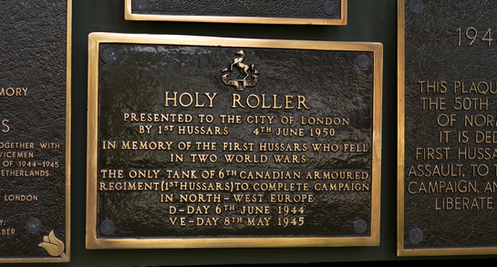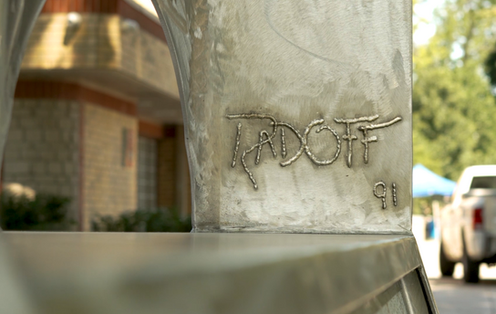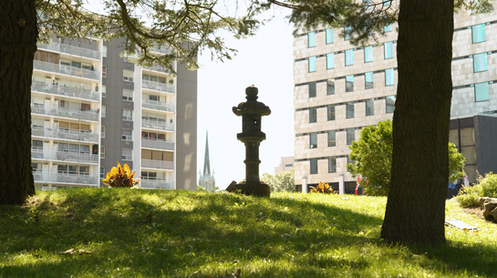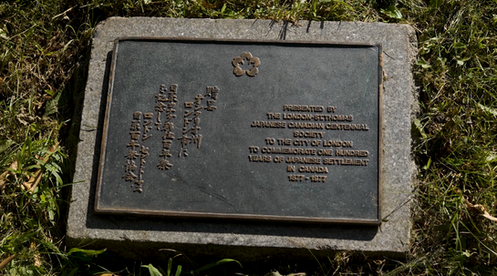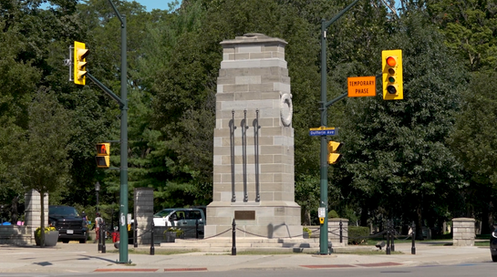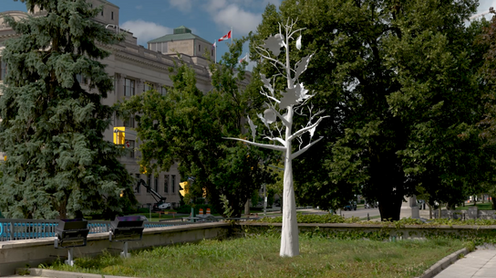
Public Art & Monument Tour
– Victoria Park –
Artwork: Red Oak by Bill Hodgson
The 'Public Art Now' Tour of Victoria Park invites a new perspective of London's historic monuments through 10 stunning, expressive multidisciplinary videos of curated musical performances accompanied by dance.
Each piece of music was performed live by members of London Symphonia, accompanied by improvisational dance by Mercedes Jane Payne, at Metropolitan United Church. The purpose behind this multidisciplinary project was to highlight London's historic monuments, while interacting with them in a new, reflective way.
This project was made possible through partnerships with London Symphonia and the City of London, and supported by the City of London's London Community Recovery Network (LCRN) Funds.
PARTICIPATING ARTISTS
Violins: Andrew Chung, Mikela Witjes
Viola: Jody Davenport
Cello: Ben Bolt-Martin
Bass: Brian Baty
Flute/Piccolo: Stephan Tam
Clarinet: Ross Edwards
Trumpet: Shawn Spicer
Trombone: Rob Stone
Percussion: Graham Hargrove, Dan Morphy
Harp: Lori Gemmell
Composer: Scott Good
Movement Artist: Mercedes Jane Payne
Videographers: Brad Spencer (Brad Beard Studio) and Stefan Sago
Locations Map

Monument Locations
Artwork: Release by Ted Bieler
HOLY ROLLER TANK
1942
General Motors' Fisher Tank Arsenal
The Holy Roller is a Canadian Army M4A2 Sherman tank of the 6th Armored Regiment (1st Hussars) which landed at D-Day and fought across northwest Europe until the end of the Second World War in Europe.
It is one of two Canadian tanks that fought from D-Day to V-E Day. It is situated in Victoria Park as the park has a military history, being the original site of the British garrison, and the grounds are preserved as an archeological site.
To see more information about the Holy Roller, visit:
MUSICAL INTERPRETATION
"We’ll Meet Again" by Hughie Charles and Ross Parker
“A classic wartime song with a message of hope for all soldiers to return home safely.”
KIWANIS BANDSHELL MEMORIAL SCULPTURE
1991
Sam Radoff
The Kiwanis Memorial Bandshell was established to honor Canada's participation in the First World War, and to pay tribute to the fallen lives. The Bandshell hosts special community and music events throughout the year. The installation of a public skating rink in front of the Bandshell is the oldest tradition, dating back to 1913.
The Kiwanis Bandshell sculpture is composed of two materials, stainless steel and granite, that rest atop a rectangular pad of poured concrete foundation. The main body of the sculpture is composed of stainless steel that has been manipulated into sweeping arches that reflect the shape of the Bandshell directly to the sculpture’s North side.
The stainless-steel panels are finished with decorative abrasions to the steel surface, creating lines and curves that shift with the light and viewing angle.
MUSICAL INTERPRETATION
"I'll Be Seeing You" by Sammy Fain
GALLERY
“A classical song from wartime that relates the emotion of wishing for the safe return of your loved ones.”
RELEASE SCULPTURE
1967
Ted Bieler
The Release sculpture was commissioned as a gift to the City of London from the Canadian Federation of University Women, to commemorate Canada’s Centennial.
According to City of London records, the sculpture was designed specifically for the garden area outside London’s Centennial Hall, where it remains today within Reginald Cooper Square.
A commemorative plaque sits in front of the sculpture, attached to a flat faced boulder.
MUSICAL INTERPRETATION
"Soul" by Scott Good
“The driving rhythms, and powerful harmony of "Soul" reflect on the upward reaching, hopeful energy expressed in this sculpture.”
CANADIAN VETERANS MEMORIAL SCULPTURE (BELL CARILLON)
Gerard Pas
The artist’s hope was that this sculpture and Carillon would invoke the knowledge of gratitude of the Dutch, for the Canadian War Veteran. Resounding a beautiful litany of song throughout the years, reminding those who come after us that we will never forget the cost of our Liberty. In 1944-45, after fighting their way through Belgium, the Allied Forces, with a large proportion of Canadian troops, liberated the Netherlands. More than sixty years later, the Netherlands, and its emigrants worldwide have never forgotten this gift by Canada, who lost nearly 8,000 soldiers fighting for their freedom and whose bodies still lay in Dutch soil to this day. On September 22, 2006, this memorial was given as a gift from the Dutch Community as an expression of thanks to Canada and its Armed Forces, for their role in the liberation of Holland and Belgium during World War II. It was presented to the WW2 Veterans of Canada and the City of London in Victoria Park. This memorial consists of 3 sections. The first, a unique musical Carillon made of 18 bronze bells suspended on a large stainless-steel tower. The second element is a granite sculpture at the base of the Carillon showing the locations of Canadian Forces cemeteries in Holland and Belgium, where 7,600 Canadian WW2 graves are located. Thirdly, as is fitting for the Dutch, a beautiful garden has been created to encompass the entire site. The concept for this memorial was originally inspired by members of the local Dutch community and further developed by Gerard Pas, a Dutch born artist. The actual production of the Carillon’s elements was fabricated and constructed by local London businesses, with the exception of the 18 bells, which were cast in the Netherlands. Remarkably, the monies used to create this memorial came almost entirely from donations of Dutch Citizens and their many friends in London and Area. In fact, some donations were made by the surviving spouses and children of Veterans who fought in those bloody battles that liberated the Netherlands.
MUSICAL INTERPRETATION
"Trio for Flute, Clarinet, and Harp, III" by Eliabeth Poston
“The exuberance of this piece expresses the vibrant, yet solemn energy evoked by the Carillon.”
VICTORIA PARK CANNONS
1800s
England & Russia
These cannons were war weapons fired in action during the Siege of Sebastopol of the Crimean War. The siege lasted from September 1854 to September 1855, making it one of the central battles of the conflict. As a war fought in trenches, cannons served as a pivotal part of the battle stratagem for the British and their allies as well as the Russians. As Russian forts and redoubts were slowly taken over, cannons and other battle paraphernalia were abandoned and procured by the victors. All three guns were brought to Canada after the British siege of Sebastopol in 1855. Sir John Carling, a municipal politician who would later serve as London’s Member of Parliament in 1891, was the main instigator in procuring the three canons for display in Victoria Park. The central of the three cannons is of British manufacture. The weapon rests atop a cast stone base with brick-and-mortar overlay. The cannon itself is cast iron. The additional loop on the cascabel indicates that this cannon is of the Blomefield design, characteristic of the late 1780s. The 2 Russian cannons are cast iron and rest atop a cast stone base with brick-and-mortar overlay. The three cannons described above have been installed in Victoria Park for the same amount of time. Though their manufacturing differs, they are roughly the same size and have been mounted on structurally similar bases.
MUSICAL INTERPRETATION
"British Grenadiers" Traditional 17th C
“This rousing march song was a significant piece of music for the British Army at the time of the Crimean War.”
JAPANESE CENTENNIAL SCULPTURE
1977
This monument was donated to the City of London by the London St. Thomas Japanese Canadian Centennial Society to commemorate 100 years of Japanese settlement in Canada. In 1877, Mazo Nagano arrived in New Westminster, British Columbia and is forever remembered as the first Japanese citizen to settle in Canada. Official Japanese emigration to Canada was established ten years later with the opening of regular steamship service between Yokohama and Canada. This new connection led to a steady increase in Japanese immigrants, including such peak years as 1906-1908 when over 9,000 Japanese citizens landed on Canadian soil. The deer, mountain, and the sun are considered national symbols of Japan. Deer are considered sacred, are a good omen, and are permitted to roam free in some Japanese cities. The mountain and rising sun carved on the monument could represent Mount Fiji, Japan’s tallest mountain, and the famed red sun featured on Japan’s flag. The main component of the Japanese Centennial Sculpture is a tiered embellished column designed with Japanese architectural details. The column is comprised of six carved stone sections. Atop the main pillar of the column rests a hexagonal enclosure, likely intended to hold a lantern or a candle. The column is topped by an elaborate pagoda with six corners that swirl upwards to imitate pedals. A bulbous finial with a pointed tip finishes the column.
MUSICAL INTERPRETATION
"Syrinx" by Claude Debussy
“Debussy’s composition for solo flute conjures a magical space – a place in which worlds meet and interact.”
KING GEORGE VI PLAQUE
1937
England
This historical plaque marks the Coronation of King George VI in 1937. The coronation of King George VI and Queen Elizabeth as King and Queen of the United Kingdom, as Dominions of the British Commonwealth, and as Emperor and Empress of India, took place at Westminster Abbey, London, on May 12, 1937.
MUSICAL INTERPRETATION
"Nimrod" by Edward Elgar
“A historical piece of music enjoyed by the British Monarchy, often performed during royal ceremonies such as coronations.”
LONDON CENOTAPH
1932, restored in 2017
England (Whitehill replica)
Six years after Canada's devastating losses in the First World War, the Imperial Order Daughters of the Empire (IODE) suggested that London, On should have a cenotaph similar to one in London, England. The one we have is no longer an exact replica as tributes to the peacekeepers and to veterans of the Korean War and the War in Afghanistan have been added. These days, the cenotaph serves as a meeting place during Remembrance Day. It is not just about remembering those who died but also thanking those who are serving. The monument is made from granite with bronze elements.
MUSICAL INTERPRETATION
"Pavane for a Dead Princess" by Maurice Ravel
"Maurice Ravel’s hauntingly beautiful Pavane expresses the melancholic emotion one might experience contemplating the meaning of the Cenotaph."
RED OAK SCULPTURE (TREES OF THE CAROLINIAN FOREST)
2007
Bill Hodgson
Red Oak is part of a series of fifty trees entitled Trees of the Carolinian Forest. The collection of brightly colored trees represents approximately 20 native species to the region, recalling London’s Carolinian Forest heritage. Originally, the Carolinian ecosystem covered southwestern Ontario, with the richest diversity of tree species in all of Canada. This project was launched by the London Downtown Business Association in 2007 with the goal of bringing more public art into the downtown core, creating a sense of community, while recognizing the city’s heritage and future plans to define itself as a “Forest City.” Each tree is inscribed with the artist’s last name, year of installation and type of tree at the base of the trunk. On the circular base of Red Oak, two arrows and the letter ‘W’ indicate the cardinal direction West. The trees are depicted in the round with two-dimensional foliage. The 15-foot-high trees appear as they would in fall or winter, sparsely decorated with oversized leaves. Red Oak is adorned by several oversized acorns, as well as oak leaves.
MUSICAL INTERPRETATION
"Introduction and Allegro" by Maurice Ravel
"Maurice Ravel’s composition serves to evoke the majesty of this unique forest, and the life energy it exudes."
WOMEN'S MEMORIAL MONUMENT
1994
Leigh Raney
The Women’s Education and Research Foundation of Ontario first proposed the creation of the Women’s Memorial Monument in December 1993 with a projected dedication date of December 6th, 1994. This date was significant as it marked the fifth anniversary of the tragic murder of fourteen women at the École Polytechnique, the event now known as the Montreal Massacre, that this sculpture was designed to commemorate.
The Women’s Memorial Monument is comprised on two partially polished slabs of granite that are erected vertically on rectangular, cast stone bases. After the initial construction and dedication of the monument, two lights, placed in-between the granite stones, were added to the artwork.
MUSICAL INTERPRETATION
"Trio for Flute, Clarinet, and Harp, II" by Eliabeth Poston
"The sorrowful nature of this music leads us to a moment of silence and reflection on this tragic massacre.”
Project Partners








